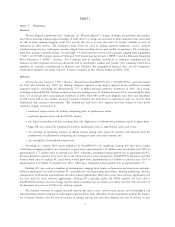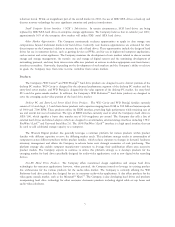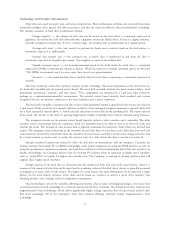Western Digital 2002 Annual Report Download - page 16
Download and view the complete annual report
Please find page 16 of the 2002 Western Digital annual report below. You can navigate through the pages in the report by either clicking on the pages listed below, or by using the keyword search tool below to find specific information within the annual report.has been a trend in integrated circuit design toward increased integration of various separate circuits. The Company
expects this trend to continue in the area of custom integrated circuits for hard drives.
For an additional discussion of component supplies, see Part II, Item 7, under the heading ""Risk factors relating to
Western Digital particularly.''
Backlog
Historically, a substantial portion of the Company's orders has been for shipments within 30 to 60 days of the
placement of the order. The Company generally negotiates pricing, order lead times, product support requirements and
other terms and conditions prior to receiving a computer manufacturer's Ñrst purchase order for a product. Customers'
purchase orders typically may be canceled with relatively short notice to the Company, with little or no cost to the
customer, or modiÑed by customers to provide for delivery at a later date. In addition, certain of the Company's sales to
computer manufacturers are made under just-in-time delivery contracts that do not generally require Ñrm order
commitments by the customer until the time of sale. Instead, the Company receives a periodic forecast of requirements
from the customer, and the customer is invoiced upon shipment of the product from the just-in-time warehouse.
Therefore, backlog information as of the end of a particular period is not necessarily indicative of future levels of the
Company's revenue and proÑt and may not be comparable to earlier periods.
Patents, Licenses and Proprietary Information
The Company owns numerous patents and has many patent applications in process. The Company believes that,
although its patents and patent applications have considerable value, the successful manufacturing and marketing of its
products depends primarily upon the technical competence and successful training of its personnel. Accordingly, the
patents held and applied for do not assure the Company's future success.
In addition to patent protection of certain intellectual property rights, the Company considers elements of its
product designs and processes to be proprietary and conÑdential. The Company believes that its nonpatented intellectual
property, particularly some of its process technology, is an important factor in its success. Western Digital relies upon
non-disclosure agreements and contractual provisions and a system of internal safeguards to protect its proprietary
information. Despite these safeguards, there is a risk that competitors may obtain and use such information. The laws of
foreign jurisdictions in which the Company conducts business also may provide less protection for conÑdential
information than the United States.
The Company relies on certain technology that is licensed from other parties in order to manufacture and sell its
products. The Company believes that it has adequate cross-licenses and other agreements in place in addition to its own
intellectual property portfolio to compete successfully in the hard drive industry.
For additional discussion of intellectual property, see Part II, Item 7, under the heading ""Risk factors relating to
Western Digital particularly.''
Environmental Regulation
The Company is subject to a variety of regulations in connection with its operations. It believes that it has obtained
or is in the process of obtaining all necessary environmental permits for its operations.
Employees
As of June 28, 2002, the Company employed a total of 9,550 employees worldwide. This represents an increase in
headcount of approximately 21% since June 29, 2001 and an increase of approximately 30% since June 30, 2000. The
increase is primarily the result of the purchase of a manufacturing facility in Thailand during 2002 in response to an
increase in unit sales. The Company employed 1,058 employees in the United States, 6,676 employees in Malaysia,
1,716 employees in Thailand, 19 employees in Singapore and 81 employees at its international sales oÇces as of June 28,
2002.
Many of the Company's employees are highly skilled, and the Company's continued success depends in part upon
its ability to attract and retain such employees. Accordingly, the Company oÅers employee beneÑt programs which it
11
























